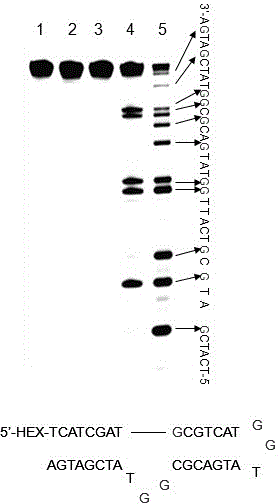Method for detecting guanines in non double-chain region in nucleic acid
A detection method, the technology of guanine, which is applied in the field of DNA sequencing, can solve the problems of being easily oxidized, and achieve the effect of sensitive detection and effective detection
- Summary
- Abstract
- Description
- Claims
- Application Information
AI Technical Summary
Problems solved by technology
Method used
Image
Examples
Embodiment 1
[0020] Embodiment 1: DNA reacts directly with piperidine
[0021] Take 2 μL of an aqueous solution (10 μM) of fluorescently labeled DNA and add it to a piperidine aqueous solution with a volume concentration of 10%. After heat treatment at 90°C for 0.5 hours, spin the solvent, and load the spin-dried sample into the electrophoresis tank After 2 hours, observe the gel results, no DNA fragmentation occurs.
Embodiment 2
[0022] Example 2: DNA is first treated with potassium tungstate, and then reacted with piperidine
[0023] Take 2 μL of an aqueous solution (10 μM) of fluorescently labeled DNA and treat it with 0.05-5 mM potassium tungstate aqueous solution for 1-10 min, then add ice ethanol to precipitate the DNA, and then centrifuge to remove the supernatant containing potassium tungstate. After the precipitate was spin-dried, it was added to a piperidine aqueous solution with a volume concentration of 10%. After heat treatment at 90°C for 0.5 hours, the solvent was spin-dried; the sample obtained by spin-drying was loaded to the electrophoresis tank, and the gel results were observed after 2 hours. There was no DNA Fracture occurs.
Embodiment 3
[0024] Example 3: DNA is first treated with hydrogen oxide, and then reacted with piperidine
[0025] Take 2 μL of an aqueous solution (10 μM) of fluorescently labeled DNA and treat it with 0.05-5 mM hydrogen peroxide solution for 1-10 min, then add ice ethanol to precipitate the DNA, and then centrifuge to remove the supernatant containing hydrogen peroxide. After the precipitate was spin-dried, it was added to a piperidine aqueous solution with a volume concentration of 10%. After heat treatment at 90°C for 0.5 hours, the solvent was spin-dried; the sample obtained by spin-drying was loaded to the electrophoresis tank, and the gel results were observed after 2 hours. There was no DNA Fracture occurs.
PUM
 Login to View More
Login to View More Abstract
Description
Claims
Application Information
 Login to View More
Login to View More - R&D
- Intellectual Property
- Life Sciences
- Materials
- Tech Scout
- Unparalleled Data Quality
- Higher Quality Content
- 60% Fewer Hallucinations
Browse by: Latest US Patents, China's latest patents, Technical Efficacy Thesaurus, Application Domain, Technology Topic, Popular Technical Reports.
© 2025 PatSnap. All rights reserved.Legal|Privacy policy|Modern Slavery Act Transparency Statement|Sitemap|About US| Contact US: help@patsnap.com

